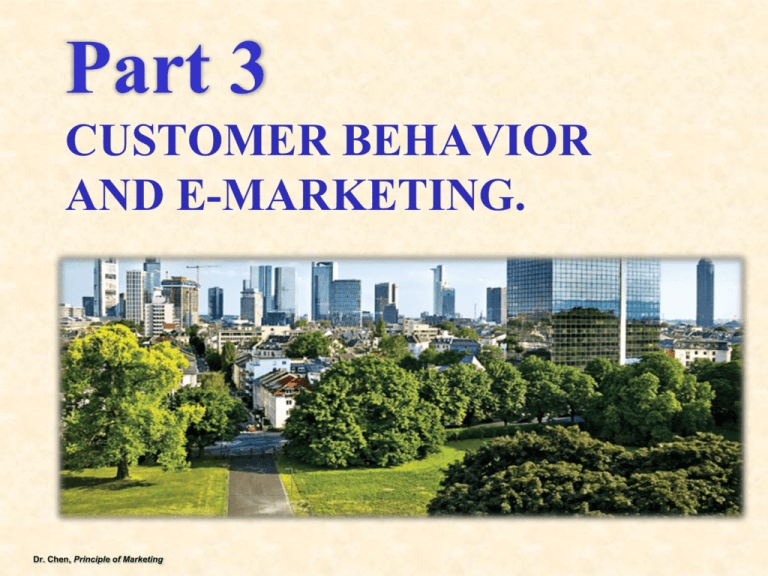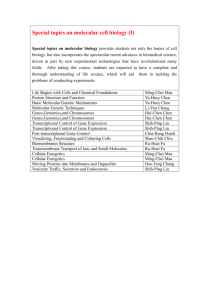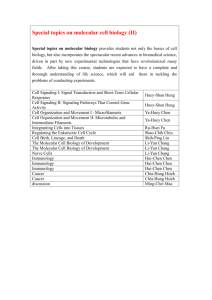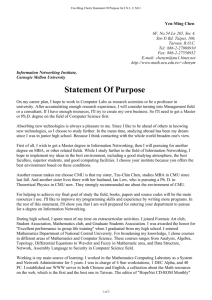
Part 3
CUSTOMER BEHAVIOR
AND E-MARKETING.
Dr. Chen, Principle of Marketing
6: Consumer Buying Behavior
7: Business Markets and
Buying Behavior
8: Reaching Global Markets
9: Digital Marketing and Social
Networking
Dr. Chen, Principle of Marketing
Chapter 9
Digital Marketing and
Social Networking
Professor Jason C. H. Chen, Ph.D.
School of Business Administration
Gonzaga University
Spokane, WA 99258
chen@jepson.gonzaga.edu
Dr. Chen, Principle of Marketing
Definitions
Digital Media
Digital media are electronic media that function using digital
codes; this includes media available through computers,
cellular phones, smartphones and other digital devices
Digital Marketing
Uses all digital media, including the Internet and mobile and
interactive channels, to develop communication and
exchanges with customers
Electronic Marketing (e-marketing)
strategic process of
The ________
distributing, promoting and pricing products and
discovering the desires of customers
help marketers to share information to the customers using
digital media and digital marketing
Dr. Chen, Principle of Marketing
4
Growth and Benefits of Digital Marketing
Marketers use __________
technology to form relationships,
coordinate, communicate, and share information with
stakeholders
It is now possible to target markets more precisely and
reach markets previously inaccessible
Small businesses - Use digital media to reach new
markets and access inexpensive communication
channels
Large businesses - Use digital media to supplement
their brick-and-mortar stores
The digital world is evolving quickly and is still in an
integration into marketing strategy
early stage of ____________
Dr. Chen, Principle of Marketing
5
Table 9.1 Characteristics of Online Media
Characteristic
Definition
_____________
Addressability
• Marketers’ ability to identify customers before
they make a purchase
Interactivity
• Customers’ ability to express their needs and
wants directly to the firm
• In response to the firm’s marketing
communications
Accessibility
_____________
• Marketers’ ability to obtain digital information
Connectivity
• Consumers’ ability to be connected with
marketers along with other consumers
Control
• Customer’s ability to regulate the information
they view and the rate and exposure to that
information
Dr. Chen, Principle of Marketing
6
Consumer-Generated Marketing
Two major trends that have caused consumergenerated information to gain importance
1)
Use of blogs or digital media by consumers to
publish their thoughts, opinions, reviews, and
product discussions
2) Consumers’ tendencies to ______
trust other
consumers over corporations
Marketers can use these online forums to
interact with consumers, address problems and
promote their company
Dr. Chen, Principle of Marketing
7
Interactivity of Social Media
The main distinguishing characteristic of
interactivity
digital media is their ____________
Traditionally, customers faced a lengthy,
dissatisfying experience when supplying feedback
Digital media allows interaction in real time
Interactivity helps marketers maintain high-quality
relationships with existing customers
Allows customer to develop relationships with
each other
Dr. ©
Chen,
of Marketing
Copyright
2014Principle
South-Western,
Cengage Learning. ALL RIGHTS RESERVED.
8
Types of Digital Media
Social networking sites: Facebook, Twitter
Blogs and wikis
Media-sharing sites: Youtube, Flickr, Podcast
Virtual reality sites: Second Life, Sim City
Mobile devices: Smartphones, Tablets, PDAs
Applications and widgets
Dr. Chen, Principle of Marketing
9
Social Networks
A social network is a web-based meeting
place for friends, family, coworkers and peers
allowing users to create a profile and connect
with other users to
get
acquainted, keep in touch, or build a work
related network
Marketers use them to:
Promote
products
Handle questions and complaints
Assist customers in buying decisions
Dr. Chen, Principle of Marketing
10
Figure 9.1 - Do You Use Social Networking Sites?
Social Networking Usage by Adult Population
Dr. Chen, Principle of Marketing
11
Social Network
Facebook
• Used by marketers to:
• Market products and interact with consumers
• Take advantage of free publicity
• Engage in e-commerce
• Engage in relationship marketing, making
consumers feel more connected to their products
Twitter
• Hybrid of a social networking site and a microblogging site
• Used to enhance customer service, create publicity
about products, and gain a competitive advantage
Dr. Chen, Principle of Marketing
12
Blogs and Wikis
Blog
• Web-based journal where
writers can editorialize and
interact with other Internet
users
• Gives consumers control
and can affect the image of a
company
• Used by corporations to:
• Answer consumer
concerns
• Defend their corporate
reputations
Dr. Chen, Principle of Marketing
Wiki
• Software that creates an
interface enabling users to
add or edit the content of
some types of websites
• Used as an internal tool for
teams on projects requiring
lots of documentation
• Provides companies with a
better idea of how
consumers feel about the
company brand
13
What is Web 2.0?
"Web 2.0" refers to the second generation of web
development and web design.
It is characterized as facilitating communication,
information sharing, interoperability, user-centered
design and collaboration on the World Wide Web. It has
led to the development and evolution of web-based
communities, hosted services, and web applications.
Examples include social-networking sites, video-sharing
sites, wikis, blogs, mashups and folksonomies.
Web 2.0 is the business revolution in the computer
industry caused by the move to the Internet as a platform,
and an attempt to understand the rules for success on that
new platform.
Source: http://en.wikipedia.org/wiki/Web_2.0
Dr. Chen, Principle of Marketing
14
Media Sharing Sites
Allows businesses to share their corporate
messages in more visual ways (e.g., photo and
video sharing and podcasts)
Limited in scope in how companies interact
with consumers
More promotional than reactive
Popularity of these sites provides wide reach
Dr. Chen, Principle of Marketing
15
Media Sharing Sites
Photo-sharing sites
• Allow users to upload and share their photos with the world
• Companies can market themselves by displaying snapshots of
their:
• Corporate events
• Staff and products
Video sharing sites
• Allow users to upload videos
• Companies can upload ads and informational videos about
their products
Podcasts
• Audio or video files that can be downloaded from the Internet with a
subscription
• Automatically delivers new content to listening devices or personal
computers
• Companies can create brand awareness, promote their products, and
encourage customer loyalty
Dr. Chen, Principle of Marketing
16
Virtual Sites
User-created, three-dimensional worlds that have
their own:
Economies
and currencies
Lands and residents
Offer opportunities for marketers to connect with
consumers in unique (creative and fun) ways
Technology used by some firms for recruiting
purposes
Virtual sites include Second Life, Everquest, Sim
City and World of Warcraft
Dr. Chen, Principle of Marketing
17
Mobile Devices
Allow customers to leave their desktops and
access digital networks from anywhere
Common mobile marketing tools
SMS
messages and multimedia messages
Mobile advertisements
Mobile websites
Location-based networks
Mobile applications: Software programs that run
on mobile devices and give users access to certain
content
Dr. Chen, Principle of Marketing
18
Applications and Widgets
Applications
Widgets
• Offer convenience and cost
savings to consumers
• Companies use mobile
marketing to offer
additional incentives to
consumers
• Allow shoppers to compare
prices or download
electronic discounts
• Small bits of software on a
website, desktop, or mobile
device
• Enables users to interface
with the application and
operating system
• Used to:
• Personalize webpages
• Alert users to company
information
• Spread product
awareness
Dr. Chen, Principle of Marketing
19
Changing Digital Media Behaviors of
Consumers
regulate the information that
Consumers are better able to _________
they view as well as the rate and sequence of their exposure
to that information.
Result of digital media
Marketers:
Have limited control over the content to which users are
exposed
Adopt a different approach than traditional marketing
Effectively target their messages to the audience
Easily track the success of their online marketing
campaign
Enjoy free publicity by way of positive customer feedback
20
Dr. Chen, Principle of Marketing
20
Online Consumer Behavior
Consumers are grouped into seven segments
according to how they interact with digital media (see
Table 9.2):
Creators – create their own media outlets such as
blogs, podcasts, videos and wikis
Conversationalists – regularly update their Twitter
feeds or status updates
Critics – are people who comment on blogs or post
ratings and reviews
Collectors – gather information and organize
content generated by critics and creators
Dr. Chen, Principle of Marketing
10-21
Online Consumer Behavior
Joiners – are anyone who becomes a member and
participates in a social networking site
Spectators – this is the largest group and is
composed of those who read what other
consumers produce but do not create any content
themselves
Inactives – online users who do not participate in
any digital online media but this number is
dwindling
By knowing how to segment the online
population, marketers can better tailor their online
messages to their target markets
Dr. Chen, Principle of Marketing
10-22
Table 9.2 - Social Technographics
Consumers are grouped into seven segments according to how they interact with digital media:
By knowing how to segment the online population, marketers can better tailor
their online messages to their target markets
Dr. Chen, Principle of Marketing
23
E-Marketing Strategy
More than one-fourth of the world’s population uses the
Internet and the number is growing.
More than three-fourths of people in North America
have Internet access
Businesses use digital marketing to gain or maintain
market share
Product considerations
__________
Opportunity to:
Add a service dimension to traditional products
Create products accessible only on the Internet
Ability to access product information for any product impacts
buyer decision making
24
Dr. Chen, Principle of Marketing
24
E-Marketing Strategy
Essential for continually upgrading products to meet
consumer needs
Online advertising campaigns and contests can be used to
help develop better products
Distribution considerations
___________
Makes products available at the right time, place, and in right
quantities
Helps businesses increase efficiency
Push-pull dynamic
Push products through the marketing channel to
consumers
Enable customers to pull products through the marketing
channel
25
Dr. Chen, Principle of Marketing
25
E-Marketing Strategy
__________
Promotion considerations
Allows marketers to approach promotion in new, creative ways
Increases brand awareness and markets to consumers
Traditional promotional events can be enhanced or replaced by
digital media
Pricing considerations
_________
Consumers gain access to more information about costs and
prices
Demand for low-priced products increases
Enables customers to compare prices of products
Sellers are pressured to:
Offer buying incentives to generate demand
Differentiate products so that customers focus on attributes
and benefits other than price
26
Dr. Chen, Principle of Marketing
Ethical and Legal Issues
Privacy
________
Online fraud
___________
Intellectual
_____________
property
_________
27
Dr. Chen, Principle of Marketing
27
Privacy
One of the most significant privacy issues
involves the misuse of personal information
collected from website visitors
May
violate user's privacy
Hackers can steal personal information
Scraping - Collecting personal information from
social networking sites and other forums
Counteractive measures
Developing
regulations to limit the amount of
consumer information that can be gathered online
Web advertisers are attempting self-regulation
28
Dr. Chen, Principle of Marketing
28
Online Fraud
Online fraud includes any attempt to conduct
dishonest activities online
Avenues for fraud
Fraudulent
profiles on social networking sites
Mobile payments
Counteractive measures
Some
firms monitor social networks for fraudulent
accounts
To avoid divulging personal information online
29
Dr. Chen, Principle of Marketing
29
Intellectual Property
Copyrighted or trademarked ideas and creative
materials developed to solve problems, carry
out applications, and educate and entertain
others
Consumers’ rationalizations for piracy
No
money to pay for what they want
Peer influence to engage in piracy and swap digital
content
The thrill of getting away with it and the slim risk
of consequence
Allows them to show how tech savvy they are
Dr. Chen, Principle of Marketing
30
Video Case 9.1
ROGUESHEEP’S POSTAGE APP: THE
POSTCARD OF THE FUTURE.
Dr. Chen, Principle of Marketing
31
Summary
This case discusses how a company is using mobile apps to
supplant traditional postcards with digital ones. RogueSheep
created the “Postage” iPhone app, a mobile app that allows
users to choose from over 90 postcard designs, customize
the design by inserting their own photos, and send the
postcard to their friends or relatives. Since its introduction,
the Postage app has won several awards and has broken into
the social networking world. To create awareness of the
product, RogueSheep uses a combination of traditional
media, apps, social networking sites like Facebook, and free
trials.
Dr. Chen, Principle of Marketing
32
1. How do you think businesses could effectively
use RogueSheep postcards in their
communications program?
Businesses can use the app to send digital postcards
to remind customers about their products or special
events. This application could potentially be
customized to be a less expensive, more impactful
business-to-the-consumer promotional postcard.
Dr. Chen, Principle of Marketing
33
2. Is it possible for RogueSheep to advance its
digital postcards to those who do not have access
to iPhone apps?
Since RogueSheep is continually creating new
products and looking into new technologies, it
seems feasible that digital postcards can be
advanced beyond iPhones. Other likely candidates
for non-iPhone digital postcards are laptops (some
people bring their laptops with them on trips),
smartphones, or iPads.
Dr. Chen, Principle of Marketing
34
3. What are the advantages of the RogueSheep
digital postcard over traditional postcards?
Advantages include saving money on postcard and
mailing costs, the speed with which a digital
postcard can reach the recipient (versus snail mail),
the ability to customize their postcards and share
their designs with others via social networks, and
the reduction of paper waste.
Dr. Chen, Principle of Marketing
35






